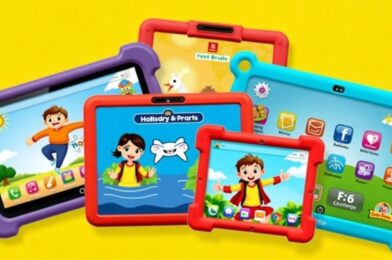Teaching kids about cybersecurity is essential in today’s digital age. As children are introduced to technology at younger ages, they become more vulnerable to online threats. By using fun and engaging methods, we can help them understand the importance of staying safe online. This article explores creative ways to teach children about cybersecurity, ensuring they develop the skills needed to navigate the internet safely.
Key Takeaways
- Understanding online dangers helps kids stay safe.
- Interactive games make learning about cybersecurity fun.
- Smart home devices need careful management for safety.
- Free resources can enhance cybersecurity education.
- Teaching privacy helps kids protect their personal info.
IMPORTANCE OF CYBERSECURITY FOR KIDS
In today’s digital world, understanding cybersecurity is essential for children. As they engage with technology at younger ages, they become more vulnerable to online threats. Teaching kids about cybersecurity helps them navigate the internet safely and confidently.
Understanding Online Threats
Children need to recognize various online dangers, such as:
- Cyberbullying: Understanding the impact of online harassment.
- Phishing Scams: Identifying deceptive messages that aim to steal personal information.
- Privacy Risks: Knowing the importance of keeping personal information private.
Building a Foundation in Online Safety
Creating a strong base in online safety involves:
- Educating about Privacy Settings: Teaching kids how to manage their privacy on social media.
- Encouraging Open Communication: Making sure kids feel comfortable discussing their online experiences.
- Promoting Safe Sharing Practices: Guiding them on what information is safe to share online.
Empowering Kids to Make Safe Choices
Empowering children means giving them the tools to make informed decisions. This includes:
- Understanding the consequences of their online actions.
- Recognizing trustworthy sources of information.
- Practicing critical thinking when encountering suspicious content.
Teaching kids about cybersecurity not only protects them but also prepares them for a future where technology plays a significant role in their lives. By instilling these values early, we can help them become responsible digital citizens.
By focusing on these key areas, we can ensure that children are well-equipped to handle the challenges of the online world, fostering a safer digital environment for everyone.
INTERACTIVE TEACHING METHODS

Teaching kids about cybersecurity can be both fun and engaging with the right interactive teaching methods. Incorporating games, videos, and classroom activities can effectively help children grasp basic concepts.
Using Cybersecurity Games
One effective approach is using cybersecurity games designed to educate students on how to stay safe online. These games often involve tackling security threats and challenges, encouraging players to think critically about their online actions and the potential risks. Here are some popular game ideas:
- Escape Room: Create puzzles related to online safety that students must solve to escape.
- Board Game: Design a roll-and-respond board game where students answer questions about cyber safety.
- Treasure Hunt: Hide objects related to online safety around the classroom and give clues to find them.
Incorporating Educational Videos
Incorporating videos into the learning process can also be beneficial. Videos can provide visual examples of important principles, making the content more engaging and easier to understand. For instance, PBS has excellent resources for multiple age groups, such as their Nova Labs Cybersecurity Lab and Cyberchase series.
Hands-On Classroom Activities
Hands-on activities can make learning about cybersecurity more relatable. Here are some ideas:
- Digital Footprint Artwork: Have students trace their feet and fill them with logos of apps they use, discussing their digital footprint.
- Role-Playing: Students can act out scenarios related to cyberbullying or netiquette to understand the impact of their actions.
- Quiz Show: Organize a quiz competition where students answer questions about cyber safety in teams.
Engaging kids through interactive methods not only makes learning enjoyable but also helps them remember important concepts better. Empowering kids with knowledge about online safety is crucial in today’s digital age.
By using these interactive teaching methods, educators can create a dynamic learning environment that fosters curiosity and understanding of cybersecurity.
SMART HOME TECHNOLOGY AND KIDS’ SAFETY

In our modern world, Smart Home Technology is becoming a big part of our lives. It includes devices like smart speakers, security systems, and even smart fridges. Teaching kids about these technologies is important for their safety.
Understanding Smart Devices
- Smart devices can automate tasks in our homes.
- They can help with security, but they also come with risks.
- Kids should learn how to use these devices safely.
Managing Privacy and Security
- Discuss the importance of privacy when using smart devices.
- Teach kids about who can access these devices and how to control that access.
- Explain the potential risks, like data breaches or unauthorized access.
Interactive Learning Activities
Engaging kids through interactive activities can make learning about smart home safety fun. For example, you can set up a scenario where kids identify risks in a smart home setup and suggest solutions. This hands-on approach helps them understand the importance of cybersecurity in their daily lives.
By incorporating lessons on Smart Home Technology into their education, we can help kids navigate this connected world safely and confidently. Almost every teenager in the United States (approximately 96%) reports using the internet daily, making it crucial for them to understand these concepts.
FREE CYBERSECURITY RESOURCES

In today’s digital world, it’s essential for kids to learn about cybersecurity. Here are some valuable resources that can help:
Government Resources
- StopBullying.gov: This site teaches kids how to recognize and respond to bullying safely.
- FBI’s Safe Online Surfing: Offers fun games and resources to help kids stay safe online.
- K-12 Computer Science Framework: A guide to help schools develop computer science standards.
Educational Platforms
- PBS: Provides quizzes, games, and a library of resources for various age groups.
- CyberSmart Challenge: Offers games and resources to keep children safe online.
- KnowBe4: Their interactive cybersecurity activity kit is freely available for schools and parents to use, making learning engaging and fun.
Community Initiatives
- US Cyber Challenge: A program that identifies future cybersecurity professionals through online competitions.
- Local Workshops: Many communities offer workshops to teach kids about online safety and cybersecurity.
- School Programs: Check with local schools for programs that focus on cybersecurity education.
Learning about cybersecurity is not just about protecting oneself; it’s about building a safer online community for everyone.
These resources can empower kids to understand and navigate the online world safely, ensuring they are well-prepared for the challenges of the digital age.
TEACHING PRIVACY AND PERSONAL INFORMATION PROTECTION
Importance of Privacy
Teaching kids about privacy is crucial in today’s digital world. They need to understand that their personal information, like their name, address, and phone number, should be kept safe. Here are some key points:
- Personal information should never be shared online without permission.
- Kids should know how to adjust their privacy settings on social media.
- They must learn to recognize what information is safe to share and what isn’t.
Managing Privacy Settings
Managing privacy settings on devices and apps is essential. Here’s how kids can do it:
- Review settings on social media accounts regularly.
- Limit who can see their posts and personal information.
- Use strong passwords and change them often.
| Device/App | Recommended Privacy Setting |
|---|---|
| Friends only for posts | |
| Private account | |
| TikTok | Only allow friends to view |
Safe Sharing Practices
Kids should practice safe sharing habits. Here are some tips:
- Think before sharing: Always ask, “Is this safe to share?”
- Avoid sharing location information in real-time.
- Use nicknames instead of real names when possible.
Teaching children about privacy helps them navigate the online world safely. They will be better prepared to protect their personal information and make informed decisions about what to share online.
ADDRESSING CYBERBULLYING
Recognizing Cyberbullying
Cyberbullying can happen in many forms, and it’s important for kids to understand what it looks like. Here are some signs:
- Mean comments or messages online.
- Spreading rumors or lies about someone.
- Excluding someone from online groups or chats.
Strategies for Coping
If kids find themselves facing cyberbullying, they should know how to handle it. Here are some steps:
- Ignore the bully and don’t respond.
- Turn off the device and walk away.
- Talk to a trusted adult about what’s happening.
Reporting and Prevention
Encouraging kids to report cyberbullying is crucial. They should:
- Use the reporting tools on social media platforms.
- Keep evidence of the bullying, like screenshots.
- Understand that they are not alone and help is available.
Teaching kids about cyberbullying helps them build resilience and empowers them to stand up for themselves and others. It’s essential to create a safe online environment.
PHISHING AND SCAM AWARENESS
Identifying Suspicious Messages
Phishing scams can come in many forms, such as emails, texts, or even phone calls. Here are some common signs to look out for:
- Urgent requests for personal information.
- Messages with poor spelling or grammar.
- Links that don’t match the sender’s website.
Safe Browsing Practices
To stay safe online, follow these tips:
- Always check the URL before clicking on links.
- Use security software to help detect threats.
- Avoid sharing personal information on unfamiliar websites.
Responding to Phishing Attempts
If you suspect a phishing attempt, take these steps:
- Do not click on any links or download attachments.
- Report the message to your email provider.
- Look for “teachable moments“ — if you get a phishing message, show it to your kids. A demonstration can help them recognize a potential phishing scam and help them learn how to avoid it in the future.
Understanding how to spot phishing scams is crucial for kids. Teaching them these skills can help them navigate the online world safely and confidently.
CREATING STRONG PASSWORDS
Importance of Strong Passwords
Creating strong passwords is essential for keeping personal information safe online. A strong password acts as a shield against hackers and unauthorized access. Here are some key points to remember:
- Use a mix of letters, numbers, and symbols.
- Avoid using easily guessed information like birthdays or names.
- Make passwords at least 12 characters long.
How to Create Complex Passwords
To help kids understand how to create strong passwords, consider these steps:
- Think of a phrase: Use a memorable sentence or quote.
- Use the first letter of each word: For example, “I love to play soccer every Saturday!” becomes “Il2pseS!”.
- Add numbers and symbols: Replace letters with numbers or symbols (e.g., “a” with “@”).
Regularly Updating Passwords
It’s important to change passwords regularly to maintain security. Here’s how to encourage this habit:
- Set reminders to change passwords every 3-6 months.
- Teach kids to use a password manager to keep track of their passwords securely.
- Discuss the importance of not reusing passwords across different accounts.
Regularly updating passwords is a simple yet effective way to enhance online security.
By following these guidelines, kids can learn to create strong passwords that protect their online presence and personal information. Remember, a strong password is the first line of defense against cyber threats!
PREPARING KIDS FOR CYBERSECURITY CAREERS
Introducing Cybersecurity Roles
To spark interest in cybersecurity, it’s important to introduce kids to various roles in the field. Here are some key positions:
- Chief Technology Officer (CTO): Oversees technology strategy.
- Network Engineer: Manages and secures networks.
- Ethical Hacker: Tests systems for vulnerabilities.
Building Foundational Skills
Empowering kids with essential skills is crucial for their future in cybersecurity. Focus on developing:
- Math Skills: Important for problem-solving.
- Critical Thinking: Helps analyze situations.
- Problem-Solving: Enables effective solutions to challenges.
Engaging in hands-on activities, like cybersecurity competitions, can provide meaningful experiences that inspire kids to explore this field further.
Hands-On Experiences and Internships
Encouraging kids to participate in internships or mentorship programs can be a game-changer. These experiences allow them to:
- Work alongside industry professionals.
- Gain real-world insights into cybersecurity.
- Develop a passion for protecting digital spaces.
By nurturing an interest in cybersecurity from a young age, we can prepare the next generation of leaders to tackle the challenges of our digital world.
ROLE-PLAYING AND SCENARIO-BASED LEARNING
Role-Playing Exercises
Role-playing is a fun way for students to learn about cybersecurity. By acting out different scenarios, they can practice how to respond to various online situations. This method helps students prepare for real-life challenges. Here are some scenarios to consider:
- Cyberbullying situations
- Phishing attempts
- Password security breaches
Risk Assessment Activities
In this activity, students evaluate the risks of using certain websites or apps. They can work in groups to discuss:
- What makes a website safe or unsafe?
- How to identify secure apps?
- The importance of privacy settings.
Mock Trials and Simulations
Mock trials allow students to explore the legal side of cybersecurity. They can take on roles like judge, lawyer, or witness to investigate a cybersecurity breach. This helps them understand:
- The legal consequences of cybercrimes
- How laws protect individuals online
- The importance of reporting incidents
Engaging in role-playing and scenario-based learning not only makes cybersecurity education enjoyable but also equips students with essential skills for the digital world.
Incorporating these activities into lessons can make a significant difference in how students perceive and understand cybersecurity.
USING CHILD-FRIENDLY EDUCATIONAL RESOURCES

Storybooks and Animated Series
Using storybooks and animated series can make learning about cybersecurity fun and relatable for kids. Here are some popular options:
- Cybersecurity Adventures: Engaging stories that teach kids about online safety.
- Animated Series: Shows that incorporate cybersecurity themes in their plots.
- Interactive Storybooks: Books that allow kids to make choices that affect the story’s outcome, teaching them about safe online behavior.
Interactive eBooks
Interactive eBooks are a great way to engage kids in learning about cybersecurity. They often include:
- Quizzes: To test knowledge on cybersecurity topics.
- Games: Fun activities that reinforce learning.
- Visual Aids: Graphics that help explain complex concepts simply.
Educational Apps
There are many educational apps designed to teach kids about cybersecurity. Some features include:
- Interactive Lessons: Engaging content that keeps kids interested.
- Progress Tracking: Allows kids to see how much they’ve learned.
- Fun Challenges: Games that teach important lessons about online safety.
Engaging young minds in cybersecurity is essential for their safety. By using various educational resources, we can help them understand the importance of protecting their personal information online.
By incorporating these child-friendly resources, educators and parents can create a supportive learning environment that encourages kids to explore and understand cybersecurity concepts effectively.
When it comes to helping kids learn, using fun and friendly educational resources is key! Check out our website for awesome tips and tools that make learning exciting. Don’t miss out on the best ways to support your child’s education!
Conclusion
In conclusion, teaching kids about cybersecurity is essential in today’s digital world. By using fun and engaging methods, we can help children understand how to stay safe online. Activities like games, role-playing, and scavenger hunts make learning about online safety exciting. When kids learn about protecting their personal information and recognizing online dangers, they become more responsible internet users. This knowledge not only helps them now but also prepares them for a future where they can pursue careers in technology and cybersecurity. By investing in their understanding of these topics, we are setting them up for success in a connected world.
Frequently Asked Questions
Why is it important to teach kids about cybersecurity?
Teaching kids about cybersecurity helps them understand online dangers and how to stay safe. It prepares them to handle risks like cyberbullying and scams.
What are some fun ways to teach kids about online safety?
Using games, videos, and hands-on activities can make learning about online safety enjoyable. Interactive lessons keep kids engaged.
How can I explain phishing to my child?
Phishing is when someone tries to trick you into giving away personal information. Teach your child to recognize strange emails or messages.
What should kids know about creating passwords?
Kids should learn to make strong passwords that mix letters, numbers, and symbols. They should also change them regularly.
How can smart home devices affect kids’ safety?
Smart devices can help keep homes safe, but they also come with privacy risks. Teach kids to use them carefully and understand their settings.
What resources are available to help teach kids about cybersecurity?
Many free resources are available, like websites from the government, educational platforms, and community programs that focus on online safety.
How can I address cyberbullying with my child?
Talk openly about what cyberbullying is and encourage your child to share their experiences. Discuss strategies for coping and reporting bullying.
What are some signs of suspicious online behavior?
Teach kids to look out for messages that seem odd, ask for personal info, or come from unknown sources. They should always double-check before clicking links.













































